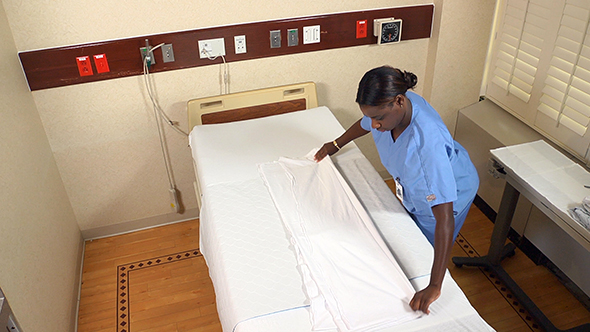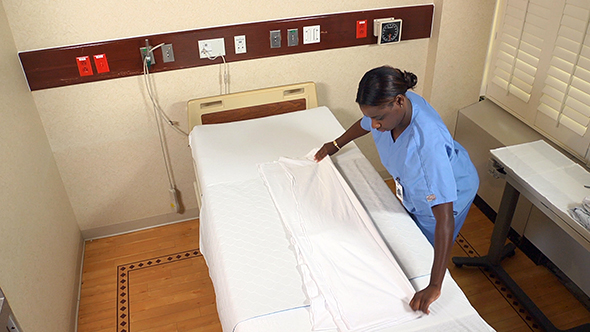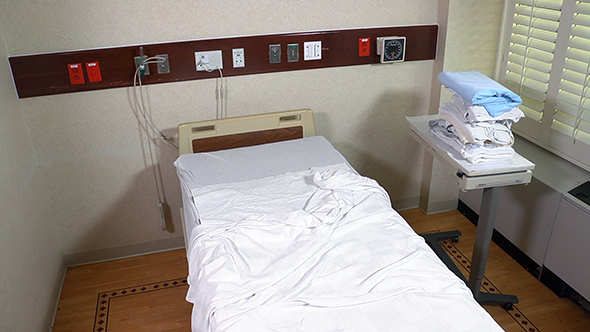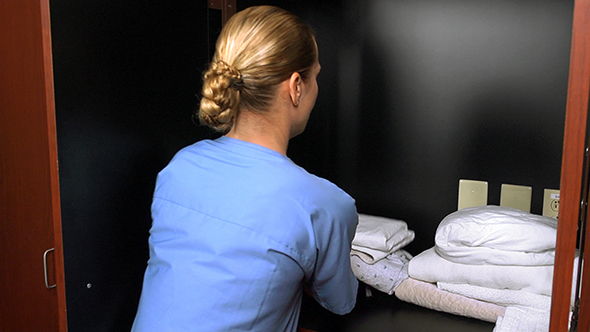Bathing and Bedmaking
Select a Skill:
- » Giving a Complete or Partial Bed Bath
- » Assisting with a Tub Bath or Shower
- » Giving Female Perineal Care
- » Giving Male Perineal Care
- » Making a Closed Bed
- » Making an Occupied Bed
- » Making a Surgical Bed
Take the Review Test:

Purpose

- Safety and medical asepsis are important for bedmaking.
- Closed beds are made for:
- New patients and residents. The bed is made after the bed frame and mattress are cleaned and disinfected. Clean linens are needed for the entire bed.
- Persons who are up for most or all of the day. Top linens are folded back at bedtime. Clean linens are used as needed.
- A closed bed becomes an open bed by fan-folding back the top linens. The open bed lets the person get into bed with ease. Open beds are made for:
- Newly admitted persons arriving by wheelchair.
- Persons who are getting ready for bed.
- Persons who are out of bed for a short time.
Equipment
Roll cursor over items to see labels. For the purposes of clearly depicting the equipment, a barrier is not shown in this photo. When providing care, a barrier should always be placed on the surface before placing the equipment.

Mattress pad, if needed
Bottom sheet (flat or fitted sheet)
Paper towels, as a barrier for clean linens
Gloves
Bedspread
Blanket
Bath blanket
Cotton drawsheet if needed
Top sheet
A pillowcase for each pillow
Bath towel
Hand towel
Washcloth
Gown
Laundry bag
Delegation
Follow delegation guidelines. Before making a bed, obtain this information from the nurse and care plan:
- What type of bed to make—closed or open
- If you need to use a cotton drawsheet
- If you need to use a waterproof drawsheet, waterproof pad, or incontinence product
- The person’s treatment, therapy, and activity schedule
- If the bed needs to be locked into a certain position
Preparation

- Review the information under Delegation and Safety and Comfort.
- Practice hand hygiene.
- Collect clean linens and other supplies.
- Place linens on a clean surface. Use the paper towels as a barrier between the clean surface and clean linens if required by agency policy.
- Raise the bed for body mechanics. Bed rails are down.
Safety

- Raise the bed for body mechanics. Have the bed flat. If the bed is locked, unlock it. Then adjust the bed. Return the bed to the correct position when you are done. Then lock the bed.
- Wear gloves to remove linens. Also follow other aspects of Standard Precautions and the Bloodborne Pathogen Standard. Linens may contain blood, body fluids, secretions, or excretions
- After making a bed, lower the bed to the correct level for the person. Follow the care plan.
Comfort
This skill does not include comfort content.
Procedure Video
Audio Description: OFFFollow-up Care

- Provide for comfort. Note: Omit this step if the bed is prepared for a new patient or resident.
- Attach the call light to the bed.
- Lower the bed to the low position. Lock the bed wheels.
- Put the towels, washcloth, gown or pajamas, and bath blanket in the bedside stand.
- Complete a safety check of the room.
- Follow agency policy for dirty linens.
- Practice hand hygiene.
Reporting/Recording
This skill does not include reporting and recording content.
Review Questions
Select the best answer.
1. What is a closed bed?
 A bed that is made while the person is in bed
A bed that is made while the person is in bed A bed that is made while the person is out of bed
A bed that is made while the person is out of bed A bed that is made after the person has been discharged
A bed that is made after the person has been discharged A bed for a person being moved from a stretcher into the bed
A bed for a person being moved from a stretcher into the bed
Select the best answer.
2. When making a closed bed, what should you do first?
 Raise both bed rails and lock all four wheels.
Raise both bed rails and lock all four wheels. Raise the head of the bed and lower both bed rails.
Raise the head of the bed and lower both bed rails. Lower both bed rails and raise the bed for body mechanics.
Lower both bed rails and raise the bed for body mechanics. Roll the person onto his left side and lower the head of the bed.
Roll the person onto his left side and lower the head of the bed.
Select the best answer.
3. What is the correct way to handle soiled linens?
 Place them in a laundry bag.
Place them in a laundry bag. Hold the linens close to your body.
Hold the linens close to your body. Shake them thoroughly to check for personal items.
Shake them thoroughly to check for personal items. Fold them and place them on the floor or over-bed table.
Fold them and place them on the floor or over-bed table.
Select the best answer.
4. Which person is most likely to need an open bed?
 A new resident
A new resident A person who is up all day
A person who is up all day A person who is up most of the day
A person who is up most of the day A person who is getting ready for bed
A person who is getting ready for bed
Select the best answer.
5. When making a closed bed, the open end of the pillowcase should face which direction?
You have completed the Review Questions for this skill. To take the Review again select the Start Over button. To proceed to another skill select from the dropdown menu. Select the Home or Back button to proceed to the next section.

